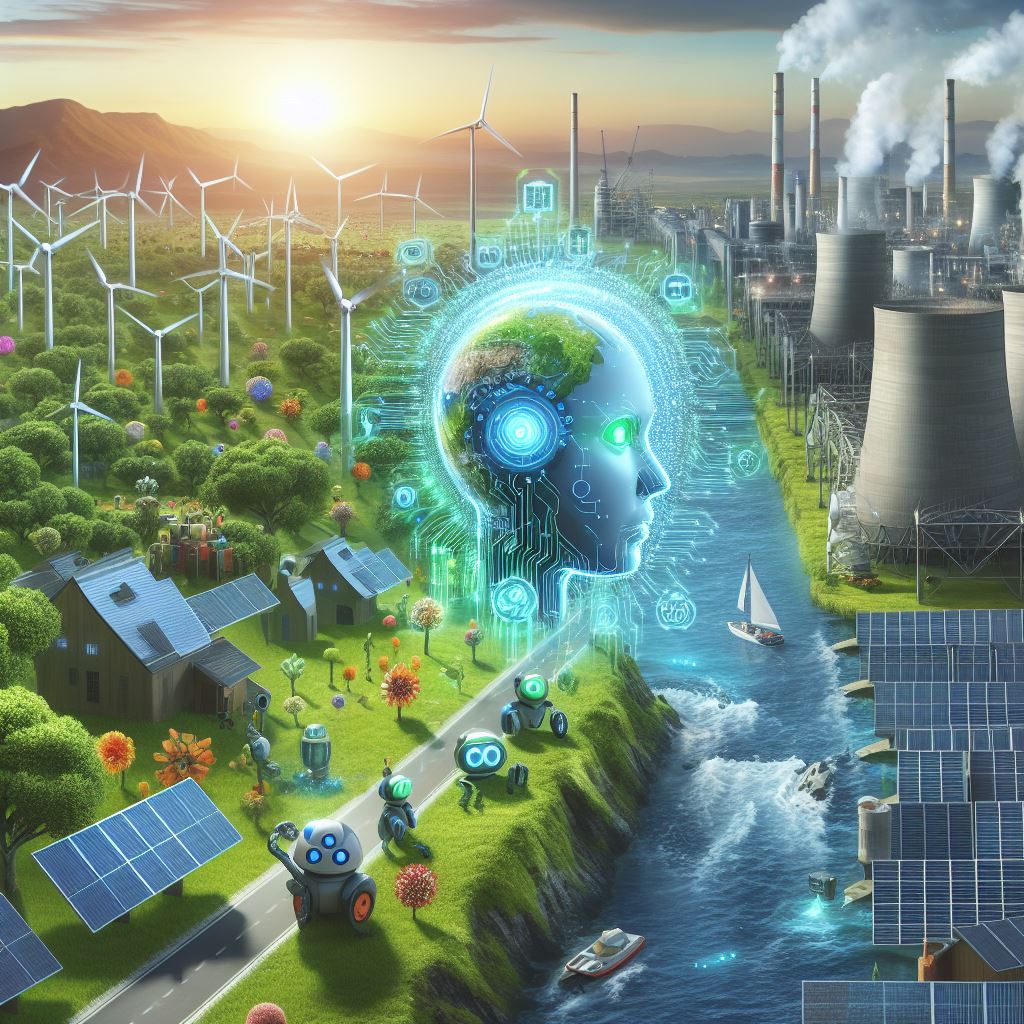Introduction
In an era marked by unprecedented environmental challenges, the quest for sustainable living has gained paramount importance worldwide. As the planet grapples with issues like climate change, deforestation, and biodiversity loss, the integration of cutting-edge technologies becomes crucial. Among these, Artificial Intelligence (AI) emerges as a beacon of hope, offering innovative solutions for environmental conservation. This article explores the transformative potential of AI, shedding light on its pivotal role in fostering a sustainable future for our planet.
Understanding Environmental Challenges
The world stands at a critical juncture in its history, teetering on the edge of an environmental precipice. The ramifications of human activities on the delicate fabric of our planet have crescendoed into an alarming cacophony. The relentless drumbeat of climate change, with its intensifying storms, rising temperatures, and erratic weather patterns, reverberates across the globe. Simultaneously, the unyielding march of deforestation, stripping away the lungs of our earth, amplifies this distressing symphony. Additionally, the rapid and accelerating loss of biodiversity, akin to a fading melody, whispers a mournful tune about our planet’s deteriorating health.
This collective symphony of environmental distress paints a haunting and sobering portrait of our Earth’s plight. It’s evident, now more than ever, that a seismic and radical shift toward embracing sustainable living practices is no longer a choice but an undeniable imperative for the survival and well-being of future generations.

Role of Artificial Intelligence in Environmental Conservation
Artificial Intelligence (AI) emerges as an unparalleled ally in our quest to safeguard and rejuvenate our environment. This groundbreaking technology, wielding the capacity to mimic human intelligence, decipher colossal datasets, and discern intricate patterns, presents an incredibly potent arsenal for conservation endeavors. Its applications span a vast spectrum, revolutionizing diverse fields from precision agriculture, where it optimizes resource usage and minimizes environmental impact, to wildlife monitoring, where it aids in safeguarding endangered species and preserving delicate ecosystems.
The transformative potential of AI extends far beyond mere analysis. It acts as a catalyst for innovation, propelling breakthroughs in ecosystem analysis by swiftly deciphering complex ecological interrelationships. This advanced intelligence not only forecasts potential environmental threats but also designs proactive strategies to mitigate and counteract them effectively.
AI’s adaptability and multifaceted nature make it an indispensable tool in the conservationist’s kit, promising unparalleled advancements in our efforts to address pressing environmental challenges with greater accuracy and efficiency.
Exploring AI’s Capabilities
AI, in its diverse forms like machine learning, neural networks, and data analytics, possesses the prowess to process massive volumes of environmental data swiftly and accurately. This ability facilitates real-time monitoring of ecosystems, enabling early detection of changes and threats. Moreover, AI algorithms learn and adapt, allowing for predictive modeling and precise interventions.
Applications in Environmental Monitoring and Analysis
The integration of AI-powered sensors, cutting-edge drones, and high-resolution satellite imagery has sparked a profound revolution in the realm of environmental observation and comprehension. These innovative technologies have transcended traditional boundaries, enabling a paradigm shift in our capacity to monitor and interpret the intricacies of our surroundings. Their collective prowess extends beyond mere observation, playing a pivotal role in elucidating deforestation patterns, meticulously tracking shifts in wildlife populations, and meticulously assessing the vitality of our oceans and forests.
Through the swift analysis of colossal data streams, these technological marvels empower conservationists with invaluable insights. This data serves as a reservoir of knowledge, allowing for nuanced and informed decision-making. Armed with this comprehensive understanding, conservationists can craft tailored interventions, strategically deploying resources to tackle environmental threats with unprecedented precision and efficacy. This real-time analysis not only offers a snapshot of our environment’s current state but also forecasts potential changes, empowering proactive conservation measures to safeguard our planet’s natural splendor.

Examples of AI Implementation in Conservation
Case Studies Showcasing Success Stories
Consider the story of how AI-powered acoustic sensors helped identify and protect endangered species like the African elephant. These sensors distinguish specific animal sounds, aiding in precise population counts and protection measures. Similarly, AI algorithms analyzing satellite imagery accurately pinpoint illegal logging activities, enabling prompt action to curb deforestation.
Effectiveness of AI in Various Conservation Initiatives
From coral reef monitoring to combating poaching activities, AI demonstrates remarkable effectiveness. Algorithms analyzing environmental data assist in restoring degraded ecosystems, optimizing resource management, and even predicting natural disasters. The marriage of AI and conservation initiatives showcases tangible results in safeguarding our planet’s natural heritage.
Advantages and Limitations of AI in Environmental Conservation
Benefits of AI for Sustainability
The strengths of AI in environmental conservation are manifold. Its ability to process enormous datasets swiftly allows for more comprehensive and accurate analysis. This leads to more effective decision-making and targeted interventions, conserving resources and maximizing impact. AI-driven solutions also streamline processes, reducing human error and increasing efficiency.
Challenges and Ethical Considerations
However, as with any emerging technology, AI poses challenges and ethical dilemmas. Data privacy concerns, biased algorithms, and the digital divide are among the pressing issues that need addressing. Striking a balance between technological advancement and ethical considerations is crucial to ensure responsible and equitable AI deployment in conservation efforts.
Future Prospects and Challenges
Potential Advancements and Emerging Technologies
The future of AI in environmental conservation holds promise with continual advancements on the horizon. Integration with other technologies like the Internet of Things (IoT) and blockchain could enhance AI’s capabilities further. For instance, AI-powered IoT devices could enable real-time monitoring of environmental parameters, fostering more proactive conservation strategies. Additionally, leveraging blockchain technology might ensure the transparency and integrity of environmental data, crucial for informed decision-making.
Addressing Concerns and Adapting to Future Challenges
As we navigate the ever-evolving landscape of AI, addressing concerns is pivotal. Ethical frameworks and robust regulations must guide AI development and usage, ensuring fairness, transparency, and accountability. Bridging the digital divide to ensure equitable access to AI-driven solutions in conservation is equally imperative. Collaborative efforts between governments, tech innovators, conservationists, and communities will be instrumental in mitigating challenges and leveraging AI’s potential effectively.
Conclusion: Paving the Way for a Sustainable Future
The fusion of Artificial Intelligence and environmental conservation heralds a new era in our quest for sustainable living. As we stand at this crossroads, the role of AI in preserving our planet’s biodiversity, mitigating climate change, and ensuring ecological balance cannot be overstated. Embracing this technology while navigating its ethical implications is the key to unlocking its transformative power.
In this pursuit, it is not solely the responsibility of scientists, policymakers, or technology developers but a collective endeavor. Everyone’s actions, choices, and advocacy contribute to shaping a future where AI becomes an indispensable tool for environmental stewardship. Let us harness the potential of AI ethically, ensuring that our quest for a sustainable world is guided by wisdom, empathy, and a shared commitment to safeguarding our planet for generations to come.
The journey towards sustainable living continues, and the integration of Artificial Intelligence stands as a beacon of hope—a powerful ally in our noble quest to preserve and cherish the marvels of our natural world.
Further Reading
- Unraveling the AI Resurgence: An In-Depth Exploration of Server Sales, Environmental Dynamics, and Industry Evolution
- Green Cities of Tomorrow: Innovations in Urban Sustainability
- How artificial intelligence is helping tackle environmental challenges:
- Environmental Intelligence: Applications of AI to Climate Change, Sustainability, and Environmental Health
